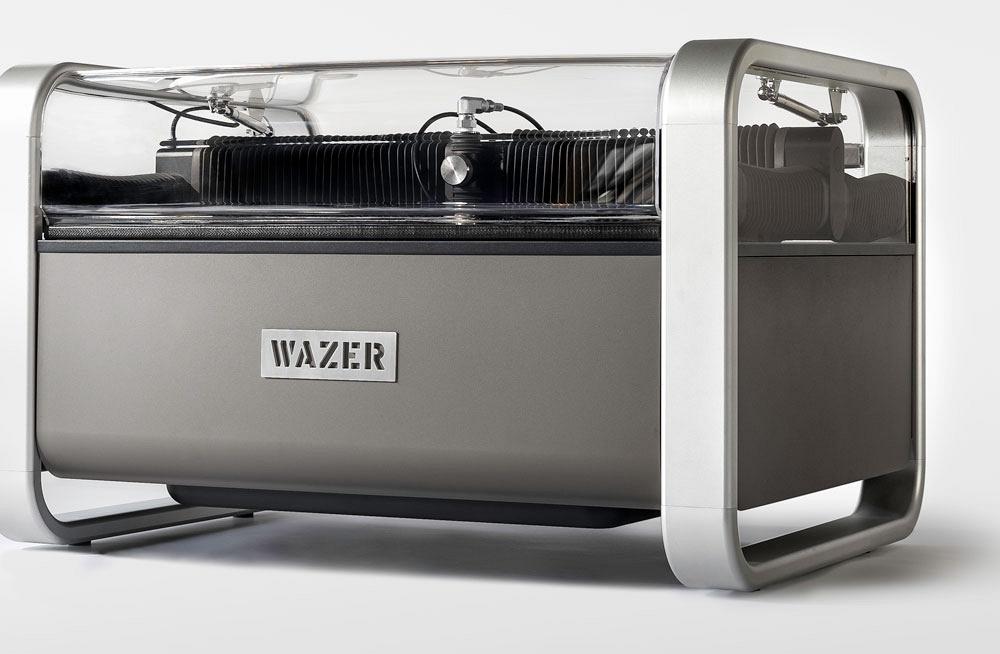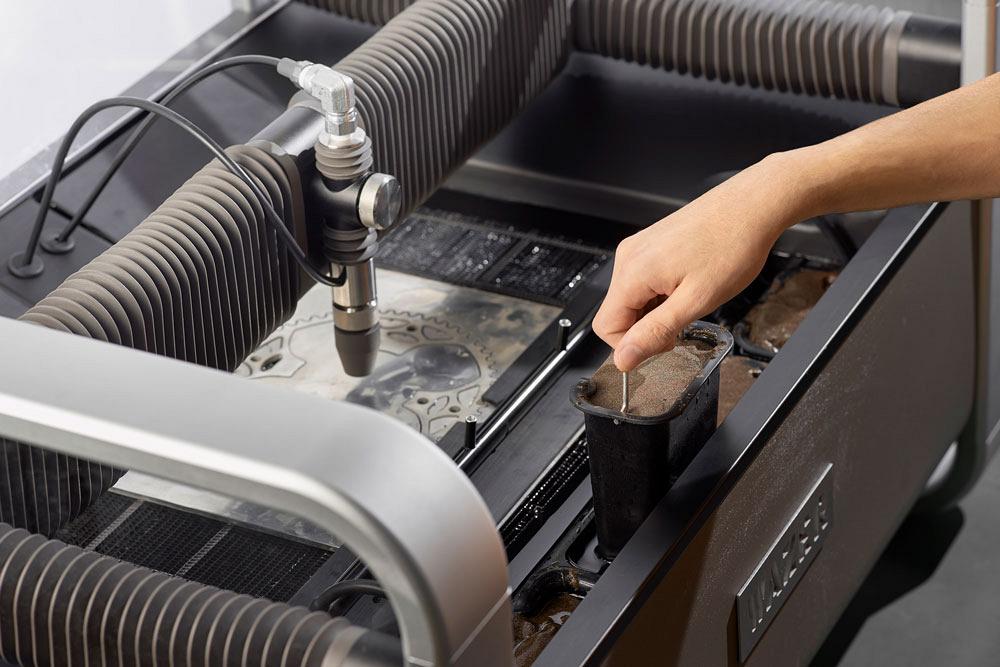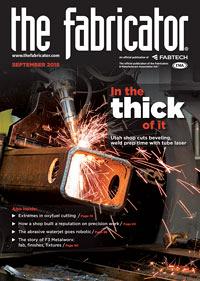- FMA
- The Fabricator
- FABTECH
- Canadian Metalworking
Categories
- Additive Manufacturing
- Aluminum Welding
- Arc Welding
- Assembly and Joining
- Automation and Robotics
- Bending and Forming
- Consumables
- Cutting and Weld Prep
- Electric Vehicles
- En Español
- Finishing
- Hydroforming
- Laser Cutting
- Laser Welding
- Machining
- Manufacturing Software
- Materials Handling
- Metals/Materials
- Oxyfuel Cutting
- Plasma Cutting
- Power Tools
- Punching and Other Holemaking
- Roll Forming
- Safety
- Sawing
- Shearing
- Shop Management
- Testing and Measuring
- Tube and Pipe Fabrication
- Tube and Pipe Production
- Waterjet Cutting
Industry Directory
Webcasts
Podcasts
FAB 40
Advertise
Subscribe
Account Login
Search
Compact waterjet cutting machine sits on a desktop
Machine tool designed for those looking for an affordable way to cut sheet metal
- September 18, 2018
- Article
- Waterjet Cutting

Figure 1
The Wazer is a fully functioning waterjet designed to sit on a desktop. It has a cutting area of 12 by 18 in.
The story of Wazer Inc. is a story familiar to all fabricators: The company founders needed a better way to cut metal, so they found a way to do it. Nisan Lerea and Matt Nowicki, the company founders, just happened to design and build their own desktop waterjet, which is a slightly new wrinkle to this type of story.
In fact, to further go against familiar story lines, the duo didn’t develop its new machine tool in a two-car garage. The development work took place mostly in a laboratory space in Brooklyn, N.Y., following a successful Kickstarter campaign, which launched in September 2016. The work over the last couple of years was aimed at building a commercial version of the desktop waterjet that Lerea and five other students built as part of their senior design project at the University of Pennsylvania back in 2012.
The fabrication lab at Penn was the place Lerea first recognized the need for a new way to cut metal. He and his engineer friends were on a team that built race cars and competed against teams from other colleges. The lab had a low-powered CO2 laser cutting machine that was useful for cutting plywood and plastic, but not for sheet metal. That’s when Lerea started to think that maybe a waterjet could do the trick. The senior design project proved the idea was a sound one.
“We realized the waterjet was not well-explored in the price range and footprint that we were targeting,” Lerea said. “We knew that industrial waterjets were capable of cutting through multiple inches of thick steel, and we knew as a university such a tool would be super useful if it could just cut 1/8-in. steel or a ¼-in. aluminum.”
By the time they were ready to graduate, the team had built a functioning desktop waterjet prototype. It had computer numerical controls and was capable of cutting ¼-in. aluminum.
“What I think was cool was that by starting from scratch, without any prior knowledge about waterjet cutting machines, we were able to take a step back and kind of redevelop the machine from the ground up through a completely different lens,” Lerea said. “What we knew we needed was a small machine that was accessible and easy to use, inside and out. So that’s where a lot of the development was focused.”
Six years and five prototypes later, the design project has evolved into a fully functioning waterjet (see Figure 1). The waterjet itself is 34 by 25 by 21 in., and the separate pump box is 21 by 15 by 11 in. Both run on a 110-V power supply. The water source is standard tap water.
The cutting area is 12 by 18 in. and completely enclosed when the door is shut. It can cut 0.125-in. 6160 aluminum at 1.7 in. per minute (IPM), 0.125-in. 316 stainless steel at 0.7 IPM, and 0.125-in. 1018 steel at 0.9 IPM.
It uses 80 mesh garnet as the abrasive for cutting and has an abrasive flow rate of 0.33 pound per minute. Lerea declined to share specifications related to horsepower and abrasive pressure.
The waterjet also comes with browser-based programming software that allows the maker or fabricator to create a part design easily and the resulting cutting path quickly. Users select the material from a library and input the material thickness, and the waterjet is ready for part production.

Figure 2
The waterjet has an abrasive removal-function that pulls the used abrasive to the front of the machine and deposits it in buckets, which then can be removed just by grabbing the bucket’s handle.
Even a desktop waterjet needs regular maintenance. Abrasive has to be cleaned out regularly (see Figure 2), and certain parts need to be replaced after a specific number of hours.
Lerea said the biggest challenge in transitioning the original product design to a commercial unit was taking a complex machine and trying to simplify it so that it was housed in a more compact package and it was affordable. The fact that the group wasn’t looking to develop a waterjet that could deliver tens of thousands of pounds per square inch of cutting power helped; by focusing on much lower cutting power, the team could focus on less expensive components. The team also had the units manufactured in China. All of these factors have led to a desktop unit that is available for less than $5,000.
“Every engineer that is designing a product is going to want one of these,” Lerea said. “If they are working with sheet metal, they are doing one of three things right now. They are either cutting parts by hand, sending out the parts to be cut by a job shop, or substituting with the wrong materials.
“Having the Wazer in-house will allow them to iterate much faster and be able to get from the initial sketch to the final design much faster.”
Learea added that the desktop waterjet also is available at a time when people are showing more of an interest in taking on custom sheet metal fabrication work, where the orders won’t be in the thousands, but on a much smaller level. Such business might include stamping houses or machine shops where custom 2-D part cutting was never considered viable (see Figure 3).
Wazer started shipping its first units in early August. Lerea said the focus now is getting the units into the hands of the people who helped support them through the crowd-funding campaign. As for a hint of things to come, he added that he thinks waterjets are “underutilized” as a technology.
People interested in seeing the Wazer in action can visit the company at the International Manufacturing Technology Show in Chicago Sept. 10-15. The desktop waterjet can be found at Booth No. 237091 in the North Building of McCormick Place.
Wazer Inc., www.wazer.comsubscribe now

The Fabricator is North America's leading magazine for the metal forming and fabricating industry. The magazine delivers the news, technical articles, and case histories that enable fabricators to do their jobs more efficiently. The Fabricator has served the industry since 1970.
start your free subscription- Stay connected from anywhere

Easily access valuable industry resources now with full access to the digital edition of The Fabricator.

Easily access valuable industry resources now with full access to the digital edition of The Welder.

Easily access valuable industry resources now with full access to the digital edition of The Tube and Pipe Journal.
- Podcasting
- Podcast:
- The Fabricator Podcast
- Published:
- 04/16/2024
- Running Time:
- 63:29
In this episode of The Fabricator Podcast, Caleb Chamberlain, co-founder and CEO of OSH Cut, discusses his company’s...
- Trending Articles
Tips for creating sheet metal tubes with perforations

JM Steel triples capacity for solar energy projects at Pennsylvania facility

Are two heads better than one in fiber laser cutting?

Supporting the metal fabricating industry through FMA

Omco Solar opens second Alabama manufacturing facility

- Industry Events
16th Annual Safety Conference
- April 30 - May 1, 2024
- Elgin,
Pipe and Tube Conference
- May 21 - 22, 2024
- Omaha, NE
World-Class Roll Forming Workshop
- June 5 - 6, 2024
- Louisville, KY
Advanced Laser Application Workshop
- June 25 - 27, 2024
- Novi, MI



























